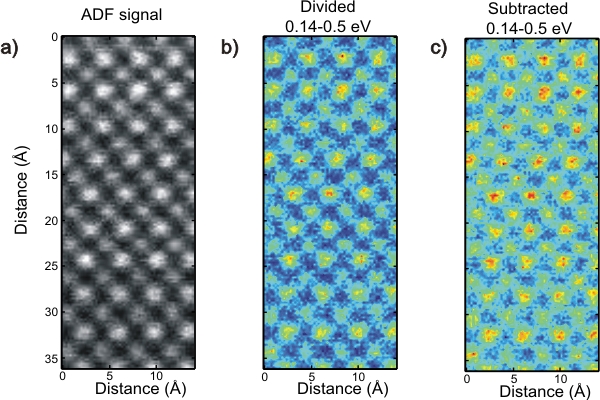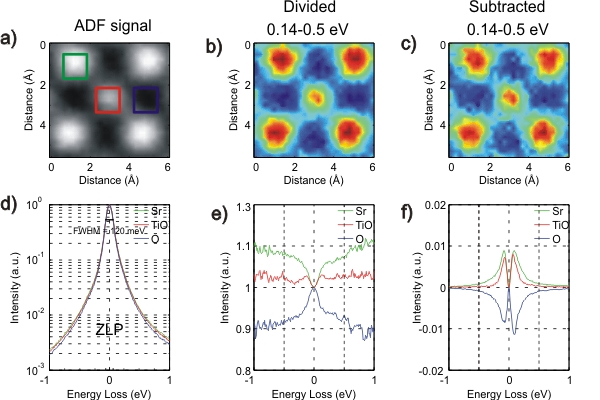IT-5-O-1847 Atomic resolution mapping of localized excitations using STEM-EELS spectroscopy
Atomically resolved EELS experiments are commonplace in modern aberration-corrected transmission electron microscopes. Energy resolution has also been increasing steadily with the continuous improvement of electron monochromators [1]. Improving the energy resolution further seems attractive in order to study phonon lattice vibrations which typically occur between a few meV and 1 eV, but with very large scattering angle (10-1000 mrad).
However these interactions are known to be strongly delocalized due to the long range interaction of the charged accelerated electrons with the electrons in a sample, and were found to scale approximately inversely proportional to the energy loss. This has made several scientists question the value of combined high spatial and energy resolution for mapping interband transitions and possibly phonon excitation in crystals.
For phonon excitations, the fast electron couples to a lattice vibration mode via Coulomb interaction, which might result in strong localization of the scattering. [2]
On the other hand, preservation of elastic contrast in low-loss EELS mapping has been reported by S. Lazar et al. [3], where the filtered image of the zero loss peak (ZLP) intensity shows the complementary nature of the high angle annular dark field (HAADF) intensity and the elastic contrast. Furthermore, atomically resolved signatures were observed at 3 eV using high collection angle (124 mrad) and addressed as being possibly related to phonon assisted losses.
In this work we demonstrate experimentally that atomic resolution information is indeed available at very low energy losses of a few hundreds meV expressed as a modulation of the broadening of the zero loss peak. [4] Careful data analysis allows us to get a glimpse of what are likely phonon excitations. On figure 1, one can note the strong presence of atomic resolution contrast hinting to localized inelastic phonon scattering. The contrast vanishes for higher energy losses where delocalized electronic excitations prevail. On Figure 2e and 2f important deviations from the average when changing probe positions within a unit cell can be observed. The spectra show both gain and loss contributions in region where multiple phonon losses are expected. These experiments confirm recent theoretical predictions on the strong localization of phonon excitations [2] as opposed to electronic excitations and show that a combination of atomic resolution and recent developments in increased energy resolution will offer great benefit for mapping phonon modes in real space.
[1] O. L. Krivanek et al., Philos. Trans. A367, 3683 (2009).
[2] C. Dwyer, http://arxiv.org/abs/1401.6305 (2014).
[3] S. Lazar et al., Microsc. Microanal. 16, 416 (2010).
[4] R. Egoavil et al., in preparation (2014).
This work was supported by funding from the ERC grant 246791 - COUNTATOMS and ERC Starting Grant 278510 VORTEX. R. E. acknowledges funding from the FP7 program grant nr NMP3-LA-2010-246102 IFOX. All authors acknowledge support from the FP7 Program Reference No. 312483-ESTEEM2. The fund for scientific research Flanders is acknowledged for funding FWO project G.0044.13N and G.0064.10N.

